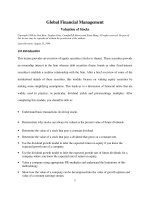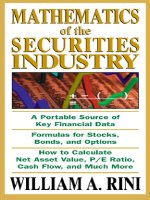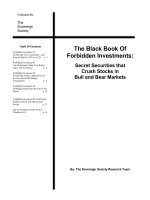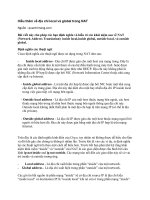Global Securities Markets pdf
Bạn đang xem bản rút gọn của tài liệu. Xem và tải ngay bản đầy đủ của tài liệu tại đây (2.3 MB, 177 trang )
Additional Praise for
Global Securities Markets
“In der Beschr
¨
ankung zeigt sich erst der Meister (Goethe) and that’s what
it is. All this historic explanatory and practical information within less than
200 pages. My compliments!! That makes it a “must have” for experienced
professionals as well as ambitious newcomers to the industry.”
—Bert Van Delft, Directeur Operations, Binck Bank, Amsterdam
“Mr. Arnett has created that rare publication that is versatile enough to
educate the securities professional, the practicing attorney, and the member
of the investing public and entertaining enough for all three.”
—David Campbell, General Counsel,
Silvercrest Asset Management, New York
“A book that should be on every securities professional’s desk”
—Matt Rochlin, Vice Chairman,
The Williams Capital Group, New York
“A well-researched and informative work, covering a broad spectrum of
issues and topics pertinent to the global securities markets—a must-read for
securities professionals and global investors.”
—Karen Tiah, Partner, Allen & Gledhill LLP, Singapore
“Tres Arnett has made it easy to understand all the things we had to figure
out for ourselves, and then automate and improve.”
—Gates Hawn, former Global Head of Financial Services,
Credit Suisse, New York
Global
Securities
Markets
Founded in 1807, John Wiley & Sons is the oldest independent publishing
company in the United States. With offices in North America, Europe, Aus-
tralia, and Asia, Wiley is globally committed to developing and marketing
print and electronic products and services for our customers’ professional
and personal knowledge and understanding.
The Wiley Finance series contains books written specifically for finance
and investment professionals as well as sophisticated individual investors
and their financial advisors. Book topics range from portfolio management
to e-commerce, risk management, financial engineering, valuation, and fi-
nancial instrument analysis, as well as much more.
For a list of available titles, please visit our Web site at www.Wiley
Finance.com
Global
Securities
Markets
Navigating the World’s Exchanges
and OTC Markets
GEORGE W. ARNETT III
John Wiley & Sons, Inc.
Copyright
C
2011 by George W. Arnett III. All rights reserved.
Published by John Wiley & Sons, Inc., Hoboken, New Jersey.
Published simultaneously in Canada.
No part of this publication may be reproduced, stored in a retrieval system, or transmitted in
any form or by any means, electronic, mechanical, photocopying, recording, scanning, or
otherwise, except as permitted under Section 107 or 108 of the 1976 United States Copyright
Act, without either the prior written permission of the Publisher, or authorization through
payment of the appropriate per-copy fee to the Copyright Clearance Center, Inc., 222
Rosewood Drive, Danvers, MA 01923, (978) 750–8400, fax (978) 646–8600, or on the Web
at www.copyright.com. Requests to the Publisher for permission should be addressed to the
Permissions Department, John Wiley & Sons, Inc., 111 River Street, Hoboken, NJ 07030,
(201) 748–6011, fax (201) 748–6008, or online at www.wiley.com/go/permissions.
Limit of Liability/Disclaimer of Warranty: While the publisher and author have used their
best efforts in preparing this book, they make no representations or warranties with respect to
the accuracy or completeness of the contents of this book and specifically disclaim any implied
warranties of merchantability or fitness for a particular purpose. No warranty may be created
or extended by sales representatives or written sales materials. The advice and strategies
contained herein may not be suitable for your situation. You should consult with a
professional where appropriate. Neither the publisher nor author shall be liable for any loss of
profit or any other commercial damages, including but not limited to special, incidental,
consequential, or other damages.
For general information on our other products and services or for technical support, please
contact our Customer Care Department within the United States at (800) 762–2974, outside
the United States at (317) 572–3993 or fax (317) 572–4002.
Wiley also publishes its books in a variety of electronic formats. Some content that appears in
print may not be available in electronic books. For more information about Wiley products,
visit our web site at www.wiley.com.
Library of Congress Cataloging-in-Publication Data:
Arnett, George W., III
Global Securities Markets: Navigating the World’s Exchanges and OTC Markets /
George W. Arnett, III.
p. cm. – (Wiley Finance ; 670)
Includes bibliographical references and index.
ISBN 978-1-118-02771-4 (hardback); 978-1-118-05660-8 (ebk);
978-1-118-05661-5 (ebk); 978-1-118-05662-2 (ebk)
1. Stock exchanges–Case studies. 2. Over-the-counter markets–Case studies.
3. Investments–Case studies. I. Title.
HG4551.A734 2011
332.64
2–dc22
2010050387
Printed in the United States of America
10987654321
To my father and grandfather, both of whom were
stockbrokers and my first guides to the securities markets;
and to my entire family.
Contents
Foreword xiii
Preface xv
Introduction xvii
CHAPTER 1
Fundamental Concepts 1
Legal Definition of Security 2
North versus South (Debt versus Equity) 4
East versus West (Derivatives versus Funds) 5
Investors 7
Brokers, Banks, and Advisors 7
Physical Securities 8
Agency 10
Purchase and Sale of Securities and the Development of
Exchanges 10
CHAPTER 2
The Growth of Exchanges around the Globe and the
Development of Screen-Based Trading 15
CHAPTER 3
The Paper Crunch and Development of New Institutions 37
The Trust 38
Central Securities Depository 39
Netting 40
Central Counterparties 41
ix
x CONTENTS
CHAPTER 4
Central Counterparties and Depositories 43
The Depository Trust and Clearing Corporation 43
Euroclear 45
ISINs 46
Access to Information Regarding Euroclear Securities 47
CREST 47
CHAPTER 5
Major Worldwide Exchanges and Their Associated
Depositories, and Practical Tips on Execution, Clearance,
and Custody in Various Regions around the Globe 49
Practical Commentary Concerning Trading, Clearing,
and Custody in Europe 50
Practical Commentary Concerning Trading, Clearing,
and Custody in South America 54
Practical Commentary Concerning Trading, Clearing,
and Custody in the Middle East and Africa 57
Practical Commentary Concerning Trading, Clearing,
and Custody in Asia 58
Passenger Markets 61
Case Study Relating to Passenger Markets 62
CHAPTER 6
Legal Framework of the World Markets 65
A Brief History of U.S. Regulation 66
The New Deal and Glass-Steagall 66
The Panic of 2008 in Context 69
The Pillars of U.S. Federal Securities Law 72
A Recent History of European Legislation 80
A Brief Comparison of U.S. Laws and EU Directives 86
CHAPTER 7
Transfer of Securities and Perfection of Collateral 89
Custody and Root of Title Internationally 91
CHAPTER 8
Margin 95
Contents
xi
CHAPTER 9
Short Selling and Stock Loans 97
CHAPTER 10
Derivatives 103
The OTC Derivative Markets 103
Legal Definition of Derivatives 105
What Is a CDS? 105
Contract for Difference (CFD) 108
Legal and Regulatory Framework of CFDs 109
The Outlook for CFDs 110
CHAPTER 11
Prime Brokerage 113
CHAPTER 12
Managed Accounts 117
History of Rule 3a-4 118
Applicability of the Advisers Act 120
Current SMA Exam Issues 121
Issues for the Future 123
CHAPTER 13
International Compliance 125
The Four Horsemen of International Compliance 126
Foreign Exchange Controls 126
Tax Reporting 126
Laws of Inheritance 127
Non-Resident Alien Estate Tax 127
Compliance Case Study 128
CHAPTER 14
Money Laundering 133
Anti–Money Laundering Case Study 137
CHAPTER 15
SIPC and Other Investment Protection Schemes around the World 141
Protection of Customer Assets by SIPC and Excess
SIPC Coverage 142
xii CONTENTS
Regulatory Obligations on Custody of Customer Funds
and Securities 142
CHAPTER 16
Risk Management 145
Conclusion 149
Afterword 151
Glossary 153
Further Reading 157
About the Author 161
Index 163
Foreword
T
he financial markets touch all of our lives. If you didn’t believe that in
years past, you surely do now after the tumultuous events of the late
2000s.
The workings and integrity of those markets are vital to our increasingly
global and interconnected economies.
If you’ve chosen a career that involves working in the securities industry,
you have a front-row seat in a dynamic and sometimes unpredictable field.
George (Tres) Arnett and I met many years ago at Yale University where
we both studied economics. And we have both spent our careers connected
to the financial services industry. The Tres I remember from those days was
intelligent, articulate, interesting, purposeful, and ethical. This book is a
reflection of those values and attributes.
Tres’s new book can help you to learn the rich history of the global
securities markets, how those markets work, and important legal concepts.
In short, Tres’s book will make you more competent in your field and better
informed. And, it should make you a better investor!
E
RIC TYSON
Syndicated Columnist
Best-Selling Author, Investing for Dummies and
Personal Finance for Dummies (John Wiley & Sons)
www.erictyson.com
February 1, 2011
xiii
Preface
T
his book is Global Securities Markets 101. But it is not a dry textbook.
It is full of rich history, interesting anecdotes, and understandable math-
ematical and legal concepts. There is no book quite like it anywhere that
weaves together all the facets of the global securities market and tells the
tale in plain readable English, at a high global level, and in less than 200
entertaining pages. And it is a feature of this book, like the hub of a wheel
arrayed with spokes, to point the reader to the right materials by Internet
link or further reading sources for more information on any given topic.
The lodestar for this guidebook is the familiar five-point star known
as a pentagram. For many (Christians, Jews, and Taoists, to name a few),
the pentagram is a symbol of faith. For ancient Greeks, the pentagram
represented mathematical perfection. And for some, a pentagram contains
dark forces and magic. In many ways, the global securities market embodies
everything in the symbology associated with a pentagram star. Markets exist
on the faith that one party will exchange with another. Markets thrive on
mathematical precision. And markets can be mysterious.
However, the global securities market is not sorcery. Using the pen-
tagram illustration featured in Chapter 1, concise explanations, and other
graphic presentations, this book seeks to demystify the global securities
markets for market participants as well as the educated investor.
There is an emphasis on history, because, as Oliver Wendell Holmes Jr.
famously declared, “A page of history is worth a volume of logic.” There is
also an emphasis on graphic presentation so the reader can easily visualize
complex material.
I would like to thank a number of my Pershing and Bank of New York
Mellon colleagues as well as our customers who have provided valuable
suggestions and input in connection with the creation of this book. Ethan
Johnson Esq. of Morgan, Lewis & Bockius (www.morganlewis.com) and
Ajay Pathak Esq., as well as Alex Leitch, Esq., of SJ Berwin (www.sjberwin.
com) provided additional legal expertise. Charlie Saulenas created the graph-
ics. Ana Pierro, Daiana Urena, Chenice Brinson, Jodi Vitale, Olga Pavez, and
xv
xvi PREFACE
Mary Neufeld organized it all. Last, I would like to thank my wife, M’lou,
for her support during the creation of this book, as well as my children (who
inspired the idea for the star pentagram chart).
G
EORGE W. (TRES)ARNETT III
Jersey City
February 2011
Introduction
W
ith more than 190 countries in the world, 320 distinct legal
jurisdictions, 110 securities exchanges, 40 derivatives exchanges, and
a withering notional value of over-the-counter derivatives and alternative
investments regularly bought and sold, investing in the global securities mar-
kets poses challenges beyond selecting a suitable security likely to provide a
decent return on investment.
In the sections that follow, we touch on fundamental concepts such as
the definition of a security; the mechanics of execution, clearing, settlement,
and custody; and the development and regulation of exchange markets and
market participants. For those interested in global equity investing, we set
forth the principal exchanges around the world and their most actively
traded stocks with Internet links for more information. In addition to cov-
ering margin, short selling, and prime brokerage, we also examine briefly
the evolving disciplines of risk management, anti-money laundering, and
international compliance. For the high-net-worth investor, there is a short
chapter on managed accounts. In brief, it is the theme of this book to tie
everything together for the global investor (and those who support him) so
that a clear and broad picture emerges of the legal, commercial, and practical
aspects of the global securities markets.
Since the law, regulation and practice developed in the United States,
United Kingdom, and European markets inform the worldwide market-
place for securities, our vantage point is principally United States, United
Kingdom, and European law and practice. Distinctions among these markets
and others around the world are noted.
xvii
CHAPTER
1
Fundamental Concepts
F
igure 1.1 encapsulates the typical flow of the global securities market
and serves as a framework for review. Although this chapter is elemen-
tary in approach, the educated professional should enjoy the chapter be-
cause it provides rich context and a solid foundation for the material that
follows.
At the bottom of the chart (the Earth if you will) are the issuers of
securities—corporations, sovereigns, and all of the many legal entities that
comprise the debt and equity market worldwide.
The investor is at the bottom-left-hand corner of the great pentagram in
the chart. The investor decides to buy a security using a broker. The broker
needs to locate a security so the broker seeks out a place where there is a
market—an exchange. The exchange provides liquidity—an active, readily
available market in those securities. The exchange members are linked to a
clearing system whereby the seller of the security (via a broker) ratifies an
order with the buyer (via the buyer’s broker). The clearing system is linked
to a central securities depository through which the two market participants
deliver securities and settle payment. At the central custodian, the investor’s
securities are held in safekeeping through the intermediation of a broker or
bank. And as neatly and as quickly as one could draw a star, the securities
pentagram is made manifest.
Overlooking the securities universe, like the sun, are the regulators. Like
the moon driving the inexorable tides, the transfer agent reconciles—day in
and day out—the securities’ positions among the depositories and the issuers
of securities.
With this overview graphically embedded in our minds, we examine the
features of the global securities firmament in greater detail.
1
Global Securities Markets: Navigating the
World’s Exchanges and OTC Markets
by George W. Arnett III
Copyright © 2011 George W. Arnett III
2 GLOBAL SECURITIES MARKETS
FIGURE 1.1 The Global Markets Pentagram
LEGAL DEFINITION OF SECURITY
A security, unlike goods or land, has no utilitarian value. A security is simply
a manifestation of a promise by an issuer to pay interest and return capital
in the case of bonds, or share in the ownership of a company in the case of
stock. In truth, a security is hard to define. It is not a check; but it can be
a note.
1
In many cases, the law resorts to a list in order to define what a
security actually is.
1
Reves v. Ernst & Young, 494 U.S. 56 (1990). What is and is not a security has meaning,
particularly in the United States, because the definition may dictate what body (for exam-
ple, the Commodity Futures Trading Commissions [CFTC] or the Securities and Exchange
Commission [SEC]) regulates the activity in the financial instrument. For example, only some
derivatives, notably options, are deemed to be “securities” in the United States. As a matter of
statutory definition in the United States, other derivatives (such as interest rate swaps and credit
default swaps) escaped traditional securities regulation because they were largely thought to
be purchased by sophisticated investors. The failure to regulate derivatives is thought by many
to be one of the causes of the 2008–2009 recession (see Chapter 10). Although interests in
investment partnerships are most often considered securities, the offering of these investment
instruments also follows a regulatory path designed for sophisticated investors.
Fundamental Concepts
3
FIGURE 1.2 The Securities Compass
Conceptually, a security can be defined as an investment pooled with
others and managed by third parties with whom the investors participate in
the economic fate of a common enterprise (whether it be a sovereign nation
or a corporation). Securities include equities, options on securities, warrants,
preferred shares, depository receipts, bonds, debentures, collateralized debt
and mortgage obligations, and mutual funds. A hallmark feature of a
security is transferability in a readily available market. In order to further
orient ourselves, a comparison to a compass may prove helpful as shown in
Figure 1.2.
Imagine the four points of a compass. North are bonds and South
are equities. East are derivatives (such as listed options or credit default
swaps) and West are investment funds. Anywhere on the compass, depending
on the characteristics of the security, one can array a financial investment
because they all tend toward one coordinate or another. Although the precise
feature of every security is beyond the scope of this book, we will examine
the principal coordinates on the compass.
4 GLOBAL SECURITIES MARKETS
NORTH VERSUS SOUTH (DEBT VERSUS EQUITY)
Issuers of debt securities induce suppliers of capital (rentiers
2
in the language
of the French economist) to part with their money in the exchange for
the promise of payment of a complete return of capital plus interest
3
at
some future point in time. This is the essence of a debt security.
4
Although
colloquially referred to as bonds, there is a legal difference between a bond
(which guarantees payment of the debt with a pledge of property) and a
debenture (another French word), which has only a corporation’s future
profits as security for future payment.
With the adoption of the law merchant into the English common law
by Lord Mansfield in the 1700s, a vibrant and international debt market
emerged.
5
Currently, the debt market (including government and quasi-
government debt, but not including loans by banks) is approximately
2
The French via a group of economic writers known as the Physiocrats gave us many of
the words of modern finance. Arguably the first school of political economic thought, the
Physiocrats placed an emphasis on protecting and developing a nation’s agriculture. Later,
Adam Smith, in The Wealth of Nations, articulated the benefits of manufacturing and free
trade. It is interesting to note, however, the protectionist doctrine of the Physiocrats (and
their predecessors, the Mercantilists) still manifests itself in national policy (such as exchange
controls, discussed in Chapter 13).
3
“I do not know what the seven wonders of the world are, but I do know the eighth: compound
interest,” said Baron Rothschild (1840–1915). Compound interest is easily described as adding
interest to interest at some agreed periodic time frame. For a detailed explanation of future
value, present value and yield calculation as well as an in-depth explanation of various fixed
income securities and bond portfolio management, one can review Frank J. Fabozzi, The
Handbook of Fixed Income Securities 5th ed. (Irwin Professional 1996).
4
The Islamic world views charging interest as morally reprehensible. Many Christians (St.
Augustine being a notable example) have taken the same view (although usually limited to
not charging extortionate rates). Exodus 22:25–27. All people must evolve legal structures in
order to advance, so Muslims developed the “Sukuk,” which is akin to a repurchase agree-
ment in which a putative borrower sells an item in return for cash and then the borrower
agrees to buy it back at some future time, only at higher price, thereby effectively paying
the lender for the use of the money. A similar practice emerged among money changers in
Lombard, Italy after a papal decree prohibited interest-bearing loans between Christians. In
time, “Lombards,” as these new money changers came to be known, developed collateralized
loan techniques that spread throughout Europe. A vocation among Jews and, later, Quakers, a
nascent banking diaspora spread throughout Europe and then to the United States. Even today,
many major European cities have a Lombard Street and some still refer to collateralized loans as
“Lombard loans.” Quakers and Jews were not the only religious groups with an impact on the
markets. For an interesting perspective on the Puritans’ impact on business and finance from
the 1630s to the present day refer to, Kenneth and William Hopper, The Puritan Gift (I. B.
Tauris 2007).
5
See C.H.S. Fifoot, Lord Mansfield (Oxford University Press 1899). The “law merchant” refers
to the customs developed among merchants concerning their dealings in goods and negotiable
instruments. Justice Joseph Story, in promoting legal precepts that aided the development of
Fundamental Concepts
5
$91 trillion. Compare this figure to the equity market of $52 trillion
(market value of issued shares) and one can see why the efficient trading
of debt has been a principal focus of efficient trading, clearance, settlement,
and custody. In fact, the two largest international central securities depos-
itories, Euroclear in Belgium and Clearstream in Luxembourg, were first
developed as custodians of debt securities.
Interest, of course, is the amount of money paid to the rentier for the
use of his capital, usually expressed as a percentage, calculated in a variety
of ways, but spelled out in a contractual document binding on the bor-
rower. The document is an indenture. The corporate trust department of a
bank typically acts as indenture trustee, collecting the issuer’s bond interest
payments and paying them to the bondholders in accordance with the in-
denture’s terms. Under this scenario, the debt holder is a secured creditor of
the debt issuer. In contrast, the equity owner (or ordinary shareholder, as
the English would say) holds a claim to corporate assets subordinated to the
bondholder and relegated to a residual claim on corporate property.
EAST VERSUS WEST (DERIVATIVES
VERSUS FUNDS)
Investment funds come in various forms—mutual funds (open-end compa-
nies investing in liquid securities), exchange-traded funds (ETFs), closed-end
funds (listed funds that are similar to ETFs), hedge funds, private equity
funds, venture capital funds, and real estate funds. The primary features
of all of these investment funds are the diversification of risk, limitation of
liability, and third-party management. Investment funds can be organized
in many ways and in many different countries. The form of organization is
often determined by the nature of the investments. For example, U.S. mutual
funds are typically organized as Delaware, Maryland, or Massachusetts cor-
porations or business trusts permitting daily redemptions and subscriptions
and are transparent (by election with the IRS) for tax purposes—meaning
that income, gains, and losses are deemed to be received by the investor
rather than the fund. The European equivalent of the U.S. mutual fund,
UCITs, are organized along similar lines. On the other hand, private equity
commerce, did the same thing for the United States that Lord Mansfield had done for England.
See, e.g., Charles River Bridge v. Warren Bridge, 36. U.S. 420 (1837). By the 1830s the London
market was awash with U.S. corporate debt (canals, railroads, turnpikes, and other enterprises),
which competed with sovereign debt for the rentier’s capital. “The barometer of the American
money market hangs up at the Stock Exchange in London,” said one congressman in 1833.
See Ron Chernow, The House of Morgan (Simon & Schuster 1991).
6 GLOBAL SECURITIES MARKETS
funds and hedge funds, which typically invest in less liquid securities and
are not offered to the public, are typically structured as Delaware limited
partnerships (or LLCs) or companies with limited liability in the Cayman
Islands, Luxembourg, or Ireland. This structure also provides for a tax trans-
parency (in the case of partnerships) or tax exemption (in the case of funds
organized in tax havens). Venture capital funds and real estate funds are
structured along similar lines because they are also typically privately of-
fered, do not have a need to provide short-term liquidity and benefit from
the flexible capital account allocation opportunities available in the limited
partnership structure. Many hedge funds are formed in offshore jurisdictions
in order to exploit available tax exemptions; however, they generally do not
want to be tax transparent for European and U.S. income tax purposes.
This is important for non-U.S. investors in hedge funds with U.S. equity
investments, as it provides a shield against U.S. estate taxes (inheritance
taxes) and trade or business taxes. The structure is also useful for shield-
ing U.S. tax-exempt investors from taxable income—specifically, unrelated
business taxable income—that is generated by the fund using margin loans
to purchase securities (rendering a portion of income derived from securities
purchased with leverage subject to tax).
Given their popularity with retail investors, it is useful to spend a few
moments on mutual funds. Mutual funds are in essence a claim to the portion
of an investment fund based on the fund’s net asset value. Particularly at-
tractive to an investor seeking diversification because mutual funds typically
invest across an array of securities, the amount of money in mutual funds has
grown tremendously since they came on the scene in Massachusetts in the
1920s. However, the growth was relatively small from the 1930s through
the 1970s, in part due to a loss of investor confidence in mutual funds after
the collapse in the 1960s of a high-profile fund called International Overseas
Services. In the mid-1990s in the United States, the average annual growth
rate was 22.4 percent. Similarly, in Europe the average annual growth rate
in the same time period was 17.7 percent. This growth, in part, stems from
their inclusion as investment vehicles for defined contribution systems in the
United States, Australia, New Zealand, and South Africa, among others.
Hong Kong, Ireland, Singapore, Switzerland, and Luxembourg have a large
number of nonresident mutual fund investors, in part, attracted to the low
tax regime in those countries. Mutual fund investments stand in contrast
to derivative securities whose values are derived from the value of another
security based on a contract without a claim, however, to any underlying col-
lective investment fund assets. Derivatives, conceptually, are much closer to
bilateral contracts. Derivatives are discussed in greater detail in Chapter 10.
Fundamental Concepts
7
INVESTORS
Investors can be divided into two groups: retail investors and institutional
investors. Retail investors—individuals investing in stocks for speculation
or investments—are but a small fraction of the marketplace. Institutional
investors—banks, insurance companies, pension funds, hedge funds, mutual
fund companies—are by far the lion’s share of the market. Particularly in
Europe, but also around the world, the tendency is for law and regulation to
protect the uninitiated but let the sophisticated investor fend for himself. For
example, the British Virgin Islands allows an international business corpora-
tion to contract as it pleases with little regulation under the theory that it is a
sophisticated corporate structure. In Germany, some courts treat derivatives
investors with sophisticated prior investment experience differently than
retail investors with no experience, mandating extensive disclosure to the
latter and affording monetary relief to the unsophisticated investor if that
disclosure was not made.
The scope of freedom of contract afforded to an investor also turns on
whether the investor was solicited by a broker or whether the investor
took the initiative and reached out to the broker. If the latter—and if
the brokerage firm where the broker works has no physical presence in
a country—then both investor and broker may escape financial regulation.
In Chile, for example, where there is no public offer of securities in coun-
try, Chilean investors are free to contract with whomever they like and
accept the application of laws governing their contracts that are outside of
Chile. It is these dual-related concepts—solicitation and sophistication—on
which the international regulation of dealings between brokers and their
customers turns.
6
BROKERS, BANKS, AND ADVISORS
Once known as a customer’s man, a broker intermediates between his
customer and the market. Typically, a broker is a licensed professional
employed by an investment firm. The investment firm will provide him with
an order management system, access to exchanges, and books and records
6
Jurisdiction-by-jurisdiction analysis of solicitation of customers, conduct of business rules,
and other cross-border legal and compliance issues can be found in Barnabas Reynolds, Inter-
national Financial Markets Guide (Lexis Nexis Butterworths, 2003).
8 GLOBAL SECURITIES MARKETS
functionality (such as the issuance of confirmations of transactions to the
broker’s customers and the publication of periodic statements to the broker’s
customers of their holdings and transactions). In a classic investment firm
model, the firm would provide investment banking
7
services for the issuers
of securities and distribute those securities through the brokers. The invest-
ment firm would give the brokers research about the issue being distributed
as well as research on other stocks from which the brokers could select suit-
able investments for their customers. Brokers are paid a commission on a
per-transaction basis.
In some jurisdictions, brokers are distinguished from investment advi-
sors. Investment advisors provide investment advice for a set fee. In the
United States, advisors are held to a slightly higher standard of care with
their customers than brokers. For example, where brokers must recommend
suitable transactions and must not act unjustly or inequitably, advisors are
held to a fiduciary standard, meaning they must always put the customers’
interests ahead of their own.
Banks and bank officers (whether trust officers or private bankers) may
recommend securities transactions as well, but (as a general rule) they em-
ploy brokers to execute those transactions. Banks play a much larger role in
the securities industry as custodians for institutional investors or indenture
trustees or as sponsors for depositary receipts.
PHYSICAL SECURITIES
When securities take a physical form, possession of a certificate in bearer
form (or possession of the certificate with a lawful assignment) is the key
to establishing successful legal ownership. A quick review in this chapter of
fundamental concepts establishes the context for the more complicated issues
of perfected liens and electronic ownership through securities intermediaries
discussed in Chapter 7. Examine this Hungarian governmental obligation
(shown in Figure 1.3).
7
It is interesting to note that just as the rise of securitized mortgages has replaced the role of
the savings banks, private equity firms have replaced the role of investment banks in marrying
investment capital with firms that need capital. Gone are the days of “3-6-3” when the small-
town savings banker paid depositors 3 percent, lent homeowners money at 6 percent, and was
on the golf course by three o’clock. Gone, too, are the major investment banks, which are now
banks themselves or are owned by banks.
Fundamental Concepts
9
FIGURE 1.3 Bearer Bond and Coupon
10 GLOBAL SECURITIES MARKETS
This bond, of course, represents a promise by the government of
Hungary, backed by the government’s ability to collect taxes, to pay the
principal amount owed and the stated interest amount. In this case, the
government’s agent, a bank, pays the interest due upon presentation of a
coupon that has been clipped from the bond and delivered to the bank for
payment (a coupon is shown under the bond). Ownership is evidenced by
possession of the bond and coupon.
AGENCY
An agent is someone with whom a principal contracts to perform a service
for the principal at the principal’s direction. An agent is frequently someone
who can commit his principal (e.g., bind the principal to a contract). When
you ask your broker to obtain 100 shares of Underwater Aircraft stock for
you, the broker acts as your agent and you are the principal. An attorney-
in-fact (as opposed to an attorney-at-law) is the principal’s appointed agent.
An example of the appointment of an attorney-in-fact is embedded in the
stock power presented in Figure 1.4. A stock power is a physical piece of
paper typically attached to the physical certificate used to legally transfer
ownership of the certificate from one person to another. In the day of paper
certificates, this power of assignment was required by the transfer agent to
transfer all physical stock certificates after the original issuance by the cor-
poration. When presented to the transfer agent, the records as to securities
ownership of the company were changed, the old certificate was cancelled
and a new one was issued, and the new owner became a registered holder
with all the rights of ownership, including the right to vote and receive
dividends (in the case of a stock) or to receive interest payments (in the
case of bonds).
PURCHASE AND SALE OF SECURITIES
AND THE DEVELOPMENT OF EXCHANGES
In the first instance, the purchase and sale of a security can be purely a
private affair between two individuals. Theoretically, nothing legally stops
Fundamental Concepts
11
FIGURE 1.4 Sample Stock Power









